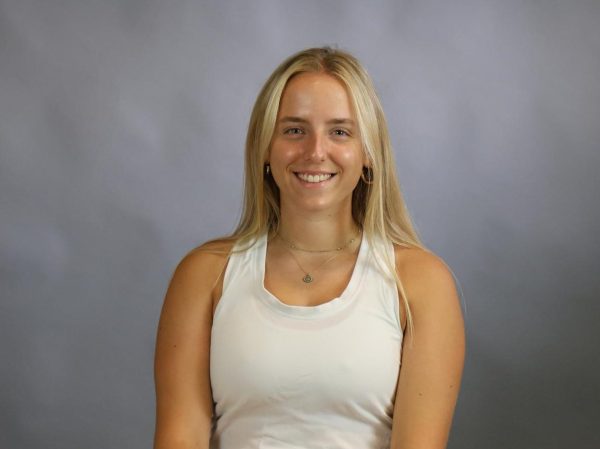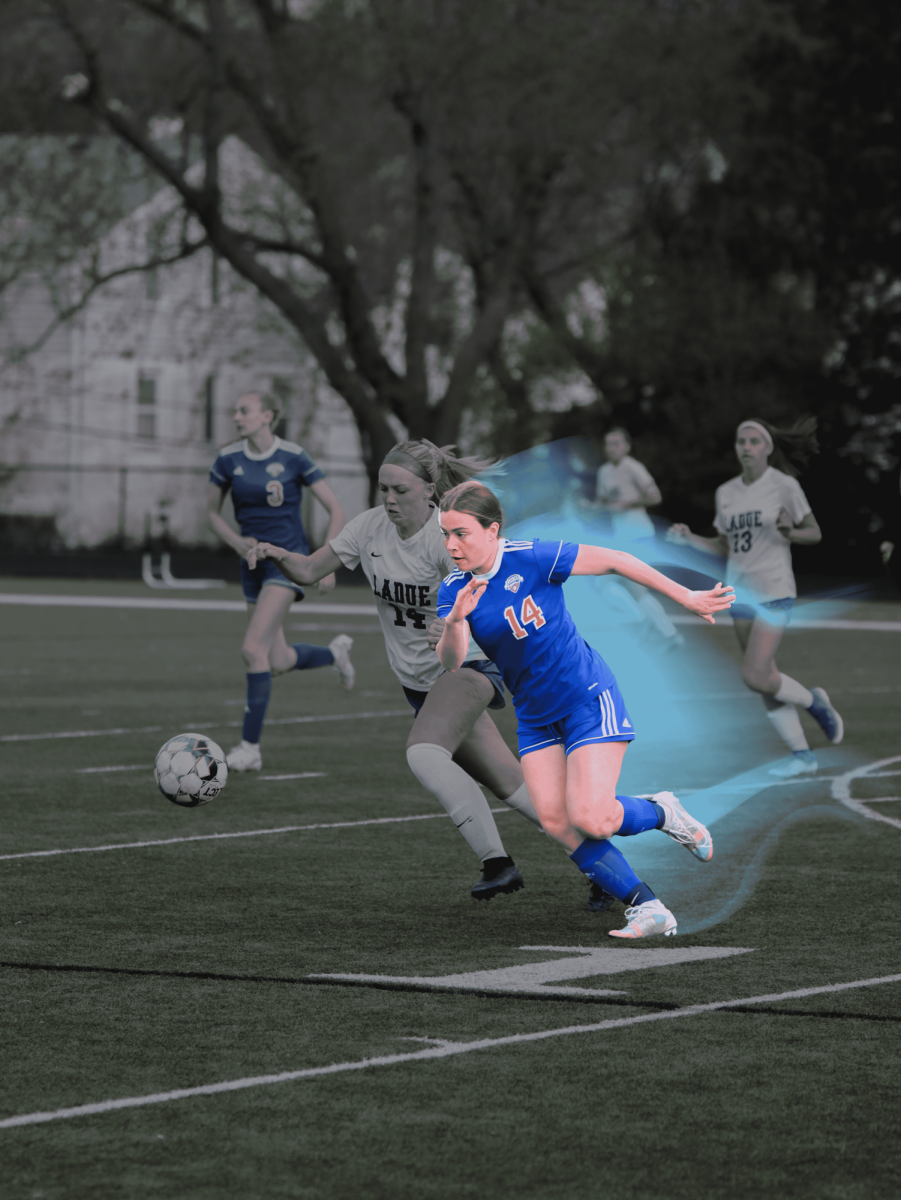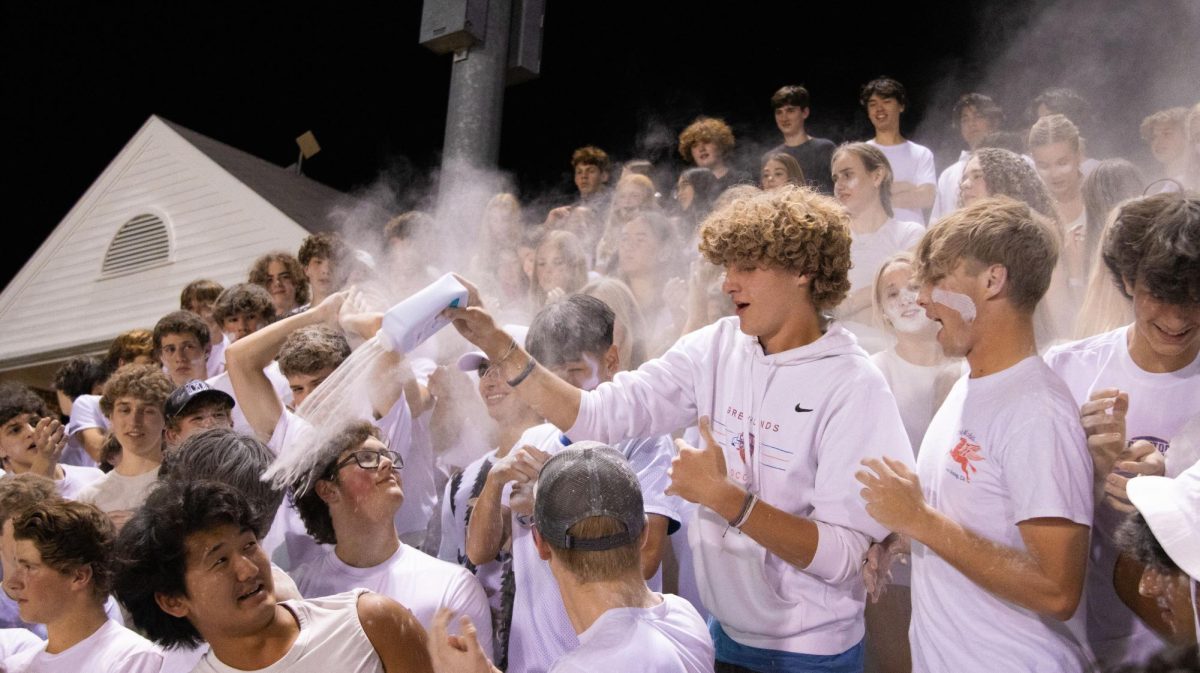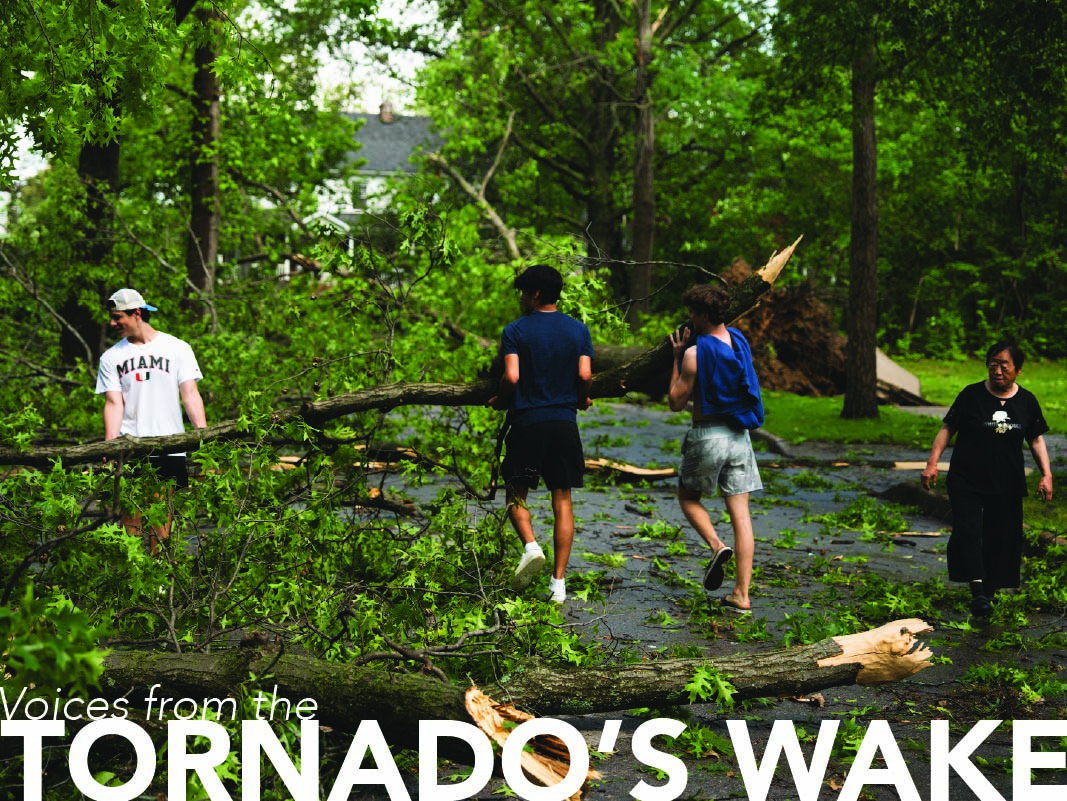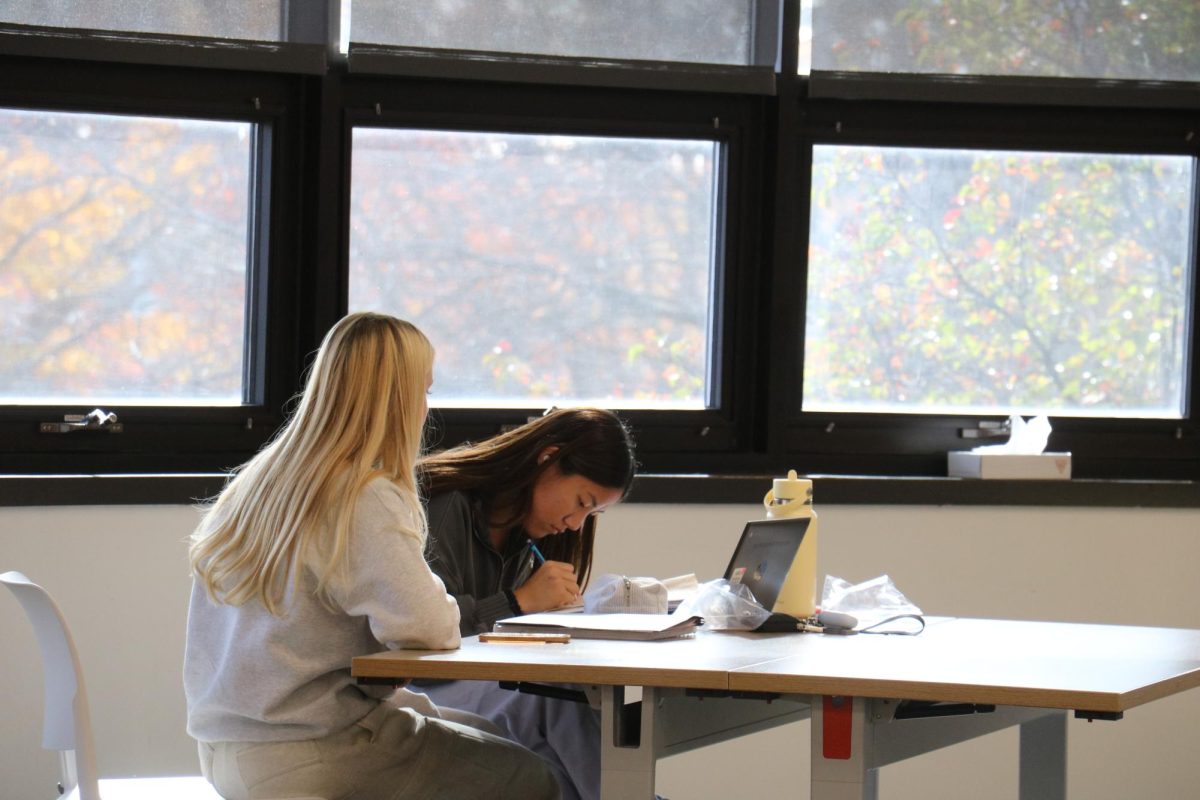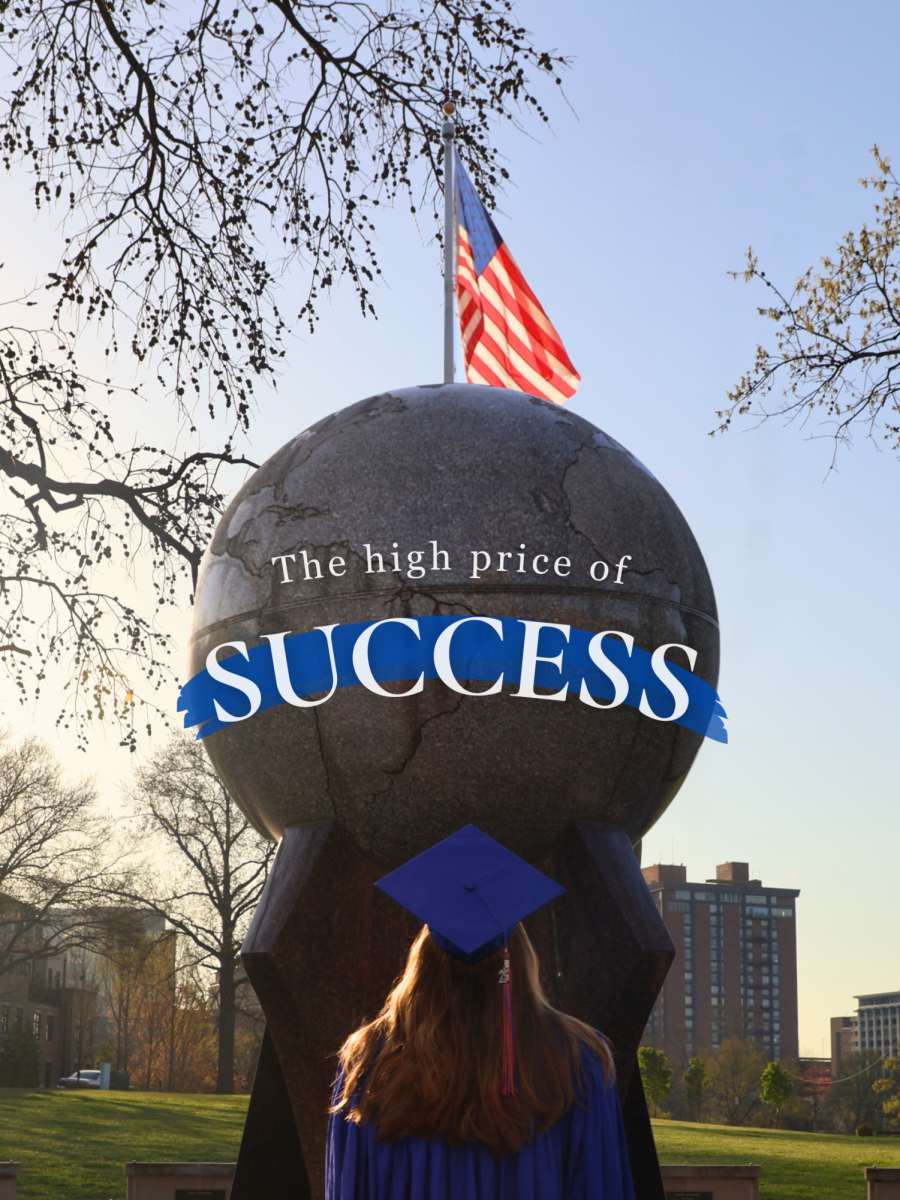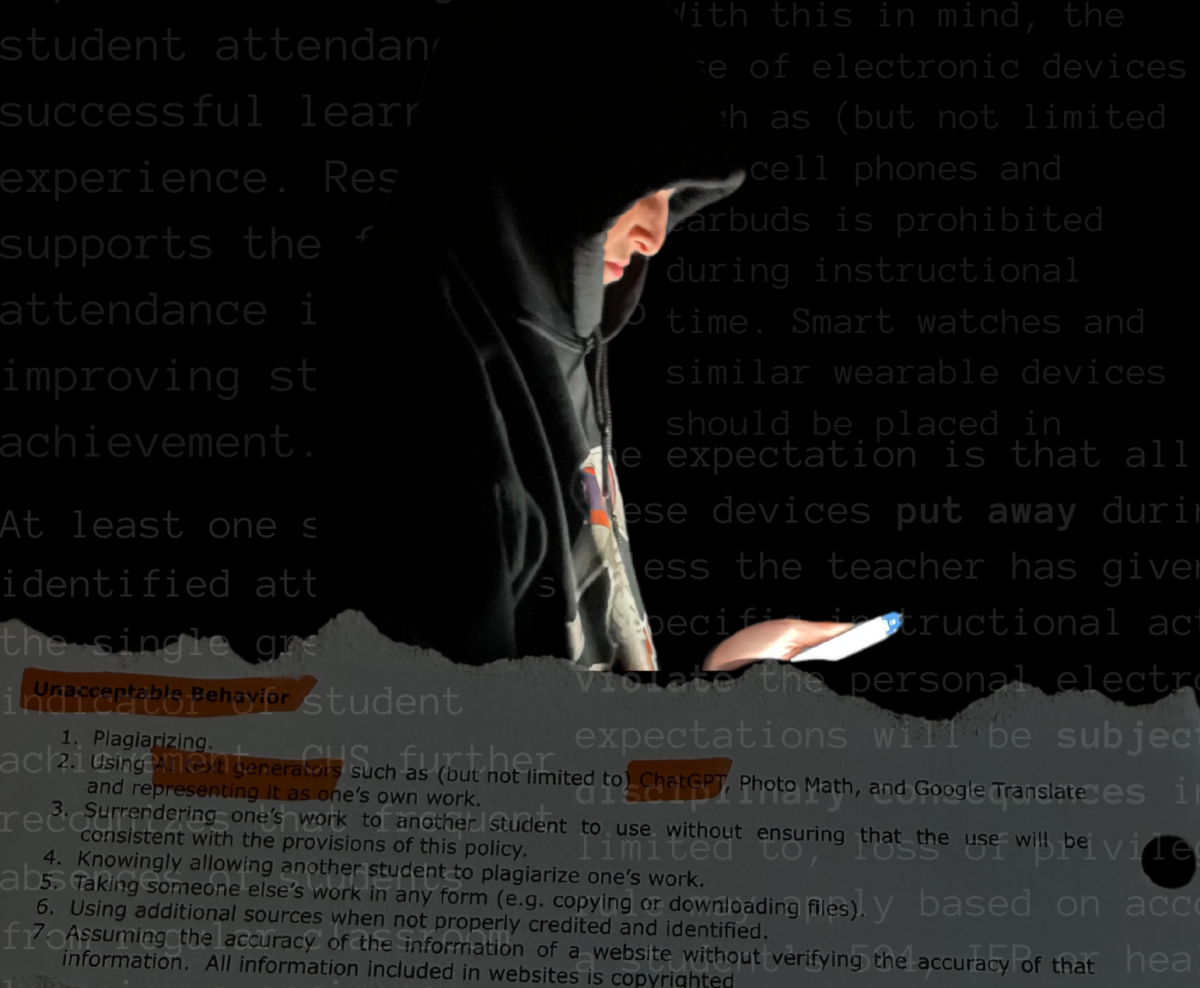Under Pressure
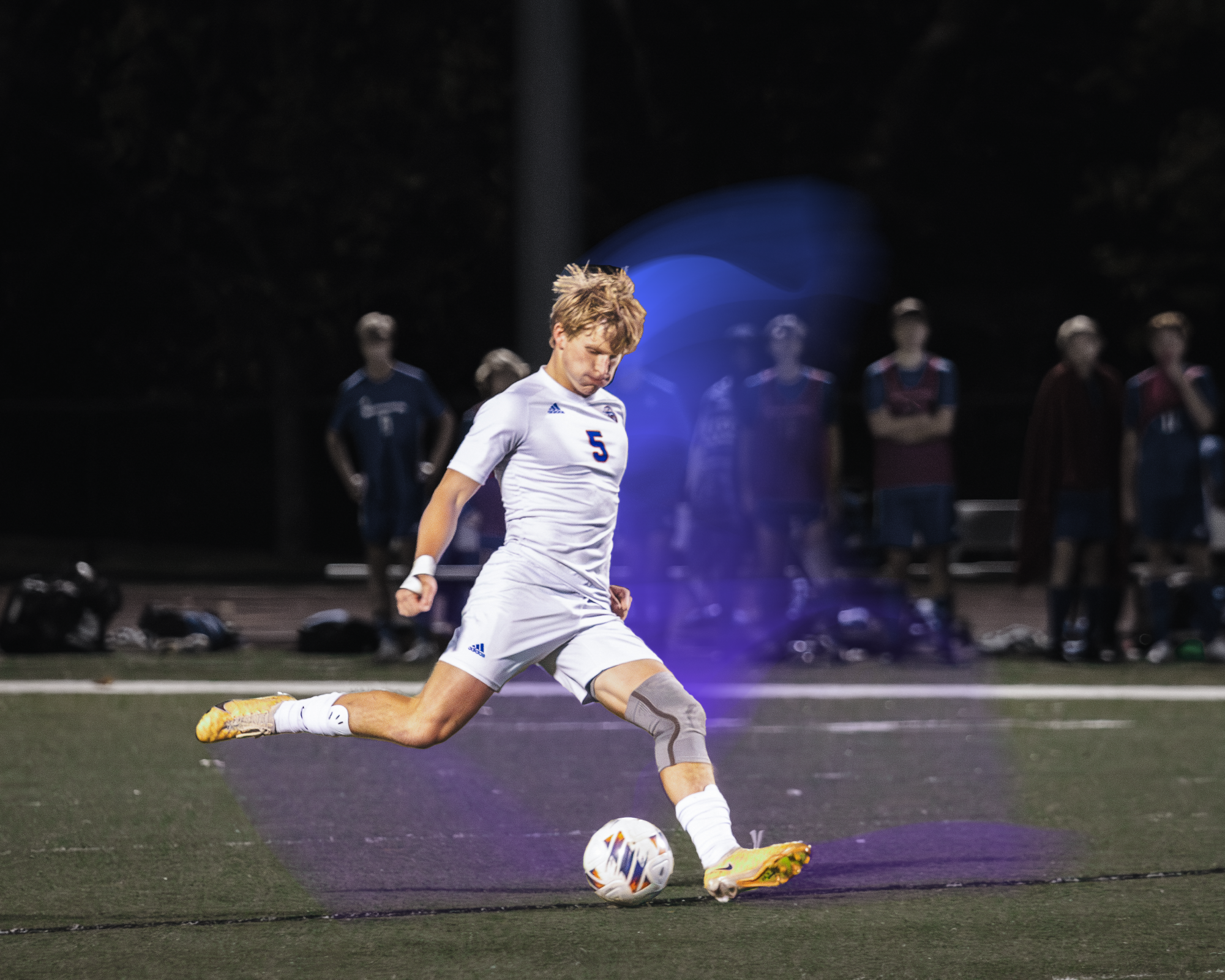
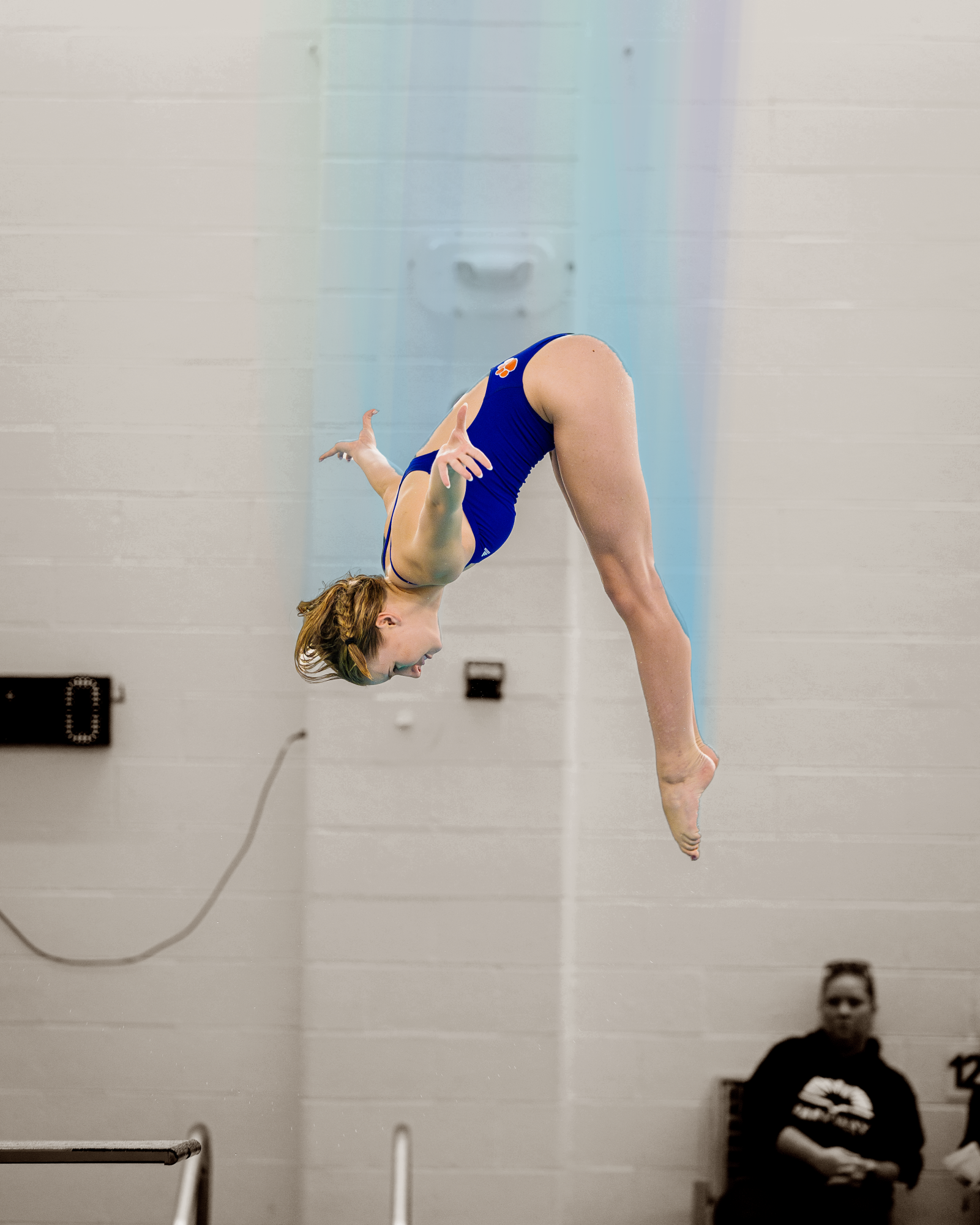
The morning air lies stagnant and lifeless, a Tuesday morning in October, full of energy and excitement for junior Anna McAndrew. It’s peak cross country and club soccer season for McAndrew, who starts her day by waking up early and drinking plenty of water, making sure she is consistently fueling herself for her five AP classes and after-school practices.
But this same night, McAndrew arrives home from cross country practice, exhausted and worn out, having no mental incentive to do her homework. Later, she goes to her club soccer practice, which extends past 10:30 p.m. When she gets home, she will stay up until past midnight, completing overdue AP chemistry labs and editing English papers, hunched over in pain from her stress-induced stomach aches.
This was a typical day for McAndrew in the fall 2023 sports season. Overworked. Overstressed. Overextended.
According to a 2023 National Library of Medicine study, approximately 91% of high school athletes out of a pool of 200 people experienced stress due to sports. Fear of failure and self-pressure were the most common causes of stress, with 27% of athletes wanting to seek help from a medical professional, but out of fear of judgment, they did not reach out to receive the assistance they needed.
While it may be easy to overlook the stress of high school athletes, rates of depression and anxiety are only growing in this population of students, leading to further health and academic concerns.
Most of this stress starts when an athlete’s sport ramps up in competitiveness and time commitment.
McAndrew, a dedicated student-athlete, has always had a passion for sports.
“Honestly, I don’t know what I would do without my sports because they’re a big outlet for me,” McAndrew said. “Some of my best friends are the people who play club (soccer).”
McAndrew is on the cross country team, track and field, the girls’ swim team, the girls’ soccer team and plays club soccer for Lou Fusz Athletics.
For McAndrew, quitting her sports was never on the table, no matter how many teams and commitments piled up on her schedule.
“I was going to quit cross country, but then that was before I fell in love with the sport,” McAndrew said. “After a few weeks of doing cross country and realizing how fun and good it is for me and my mental health, I definitely would have never planned on dropping.”
While she was always fond of physical exercise, she found a sustainable balance as an underclassman. She was able to accomplish all of her school work and attend practice, with hours to spare for her social life and relaxation.
But she didn’t realize the leap of rigor that the sophomore-year to junior-year transition would cause.
“It’s like a wake-up call after freshman and sophomore year, where I got the work done, and I’d finish it and still have time. But this year, it was like, hours and hours of work where that was the only thing I did on my weekends,” she said. “I’m having to kind of put school sports ahead of all my other priorities and relationships with people. It’s disappointing, but it’s what I have decided.”
McAndrew noted the sustainable balance that school-sponsored sports offer teenagers, with grade minimums and staff involved in sports schedules to help offer leniency.
However, the same leniency and care for schoolwork do not exist in the club atmosphere.
“We would complain to [my club coach] about how late practice was going because we had practices that went to like 10:30 in the fall. I was exhausted because I had run beforehand and had homework to do,” Mcandrew said. “It didn’t seem that they had factored in the fact that we might have school work to do too.”
University of Washington Athletics sports medicine physician Ashwin L. Rao, MD, explained that a considerable debate surrounds youth sports specialization and professionalization, in which coaches or programs ask adolescent athletes to practice and play like professionals.
The pervasive mental health struggles among elite teen and young adult athletes can lead to physical and mental issues that can have long-term impacts.
An analysis of mental health studies among elite athletes published in 2019 in the British Journal of Sports Medicine found that 34% of mental health issues among athletes are those of anxiety and depression.
McAndrew was a part of that population. On those nights of physical pain and mental turmoil, her mother would often have to intervene.
“Those were the nights my mom was like, ‘Anna, if you have to miss an assignment or get a B or C on a test, that’s what you’re going to have to do,’” she said.
While teachers may grant McAndrew extensions or simple understanding, there still aren’t enough hours to complete everything on her to-do list. With that, McAndrew has often endured a more challenging time when she would miss schoolwork for club soccer.
“I feel like with extracurriculars that are school-sponsored, teachers are way more lenient. They’re like, ‘Oh, yeah, I’ve heard of that, I’ll give you a break on that.’ But when they don’t hear something, that makes it more difficult. It’s forced me to work harder in school,” McAndrew said.
Similarly, senior Ava Vetter, Lou Fusz soccer player, D1 soccer commit at the University of Missouri-Columbia, and experienced student-athlete, has faced many pressures in her recruitment and competitive club competition era.
“I’ve played at least every sport at CHS,” Vetter said. “In the fall, I’ve played tennis, golf, and field hockey, and in the winter, I’ve played basketball and girls’ diving, and in the spring, soccer and lacrosse.”
Despite Vetter’s experience balancing a schedule for her multiple sports, club athletics consistently seep into her school hours, not allowing enough time for her studies- much less time for herself.
In the fall of 2023, Vetter would start the day before sunrise with a personal trainer twice weekly. She participated in training once or twice a week, with two AP classes and a gym session almost daily. After school, Vetter would go to school field hockey practice, leaving that practice early for club soccer practice.
Vetter explained how, at the end of the day, when one arrives at club for practice, it is always soccer first. For Lou Fouz and many other club teams, it is not abnormal to be at a practice for an hour more than expected, whether because one stays after practice to talk with a coach or because a group of kids arrived early to get some shots off.
“It’s a full-time commitment,” Vetter said.
Yet club coaches have no need or incentive to care about school-related issues.
“It’s tough, like, if you have a test at 8 a.m. the next morning, but you get off at 10:30 p.m. the night before, you just have to wake up and deal with it. I can’t control soccer, and he’s gonna keep you till whenever he needs to,” Vetter said. “During finals week, it was tough. They prioritize athlete over student.”
Research indicates that the mental and emotional stress from experiencing intense wins and losses in club and high school sports can overwhelm athletes and impact their performance at practices. In Vetter’s case, this correlation manifested in a significant toll on her mental health.
“It’s especially hard to be down in front of other people in club because I’m usually the happy person and the person that’s always fine, but I’m not always fine,” she said.
The same busy club schedule is mirrored in Sam Leonard, a junior who has played in the STL City Soccer Futures program since his freshman year. From playing U16 to now preparing to commit to college and playing on a U21 team, his high school years have been filled with week-long tournaments and practices after school. Unlike McAndrew and Vetter, however, he has never played soccer for the school.
Leonard’s busiest time throughout the year is when he has tournaments, most of which are out of town. Missing anywhere from one to four days of school, he’s had tournaments in Maryland playoffs in Texas, and for every day he’s away, he plays multiple games.
“It’s been pretty hard because every weekend I have a game. A lot of them are away, and we’d leave midday Friday and get back late Sunday,” Leonard said.
Similar to Vetter, finals week has been a bigger stressor for those in club sports.
“I try to keep in contact with [my teachers] a lot, but it’s been pretty hard because the past two years I’ve missed a lot of time right before finals,” Leonard said. “It was unlucky both times actually, because I was sick for like a week beforehand. Then I leave for a week for a tournament, so I miss two weeks, and after I have to make up a bunch of stuff. That really hurt my grades,” he said.
Leonard’s club season starts in the summertime with preseason. For all of November, he has tournaments, with playoffs in December and a one-month break in January. Then the season progresses with showcases and games, playoffs in the late spring and nationals in the summer, which then circles back to preseason. So, with only one break a year from the rigor of his club team, it can be hard to find time for physical and mental relaxation.
“As much as I love soccer, I need some time off. The time off that we do get is really good. I have to keep in shape and stuff, but I’m able to go off and do whatever without worrying about anything,” he said.
Leonard noted how STLC makes the most of their time, ensuring their players are well prepared for games with targeted drills and weight room visits. While these practices last less than two hours right after school, they leave Leonard fatigued and unmotivated.
“I do have the time to do my homework, but I’m just always tired. So I get back, and the last thing I want to do is homework, which has become a problem for me,” Leonard said. “That’s partly my fault because I haven’t been as responsible, but I just get so exhausted.”
In light of the sheer mental and physical exhaustion that comes from the commitment to club sports on top of academics, burnout is not uncommon in the world of serious sports.
Alexander Eser, a Market Data analyst, noted how, according to a New York University review, 45% of teenage athletes quit sports, and 70% of younger children quit sports by age 13 due to burnout.
Before Vetter was strictly playing for Lou Fusz, she bounced around clubs from her eighth-grade year to her sophomore year. With the changing of teams, and above that, the changing of levels she was playing on, it was hard to find a stable future for soccer in her life.
“In Covid time, I felt 100% on the verge of burning out. I mean, at that time, I was switching from one team to another that was like four levels higher, and it was not easy. Throughout that whole time, I did not feel like I was good enough,” she said. “I’ve thought about quitting before. So many people get burnt out. It could be from a coach; it could be from overworking yourself, from your parents.”
For Leonard, the concern is also prominent in his day-to-day soccer experiences, bringing up the possibility of quitting the club in the 2024-25 season, to play for Clayton once he’s committed to a college for soccer.
“I’ve been thinking about it a little bit because a lot of kids on my team have quit just because of burnout. They just want to have fun in school. If I can get in with this offer, it would be more fun if I didn’t have that pressure and time commitment,” Leonard said. “It’s a big decision, though.”
Almost two years ago, the school athletic department ended its “No-cut policy,” which allowed students to participate in any school sport without being cut from the team. With the termination of this policy, the athletic department and administration hoped to increase student play in sports with less participation and avoid staff and resource shortages for overpopulated ones. But has it worked?
Although transitioning to a more traditional sports participation policy is still fresh, Clayton has succeeded this year. Both the girls’ and boys’ Varsity tennis teams took home the gold at the state championship their past seasons after placing third and second the year before, and the girls’ swim and dive team won second place this year after placing third two years prior.
Nonetheless, the hope for a policy to direct more players to less popular sports has yet to be achieved.
“At the end of last school year, when Coach Ava Hughes, the girl’s field hockey coach, and I started planning for the upcoming season, we realized we were barely going to have enough [players] to fill a varsity team,” Athletic Director Steve Hutson, said during Episode 5 of the Greyhound Time podcast.
Upon further data analysis, Hutson identified a deficiency in the number of female athletes in school sports. At first, he saw the dilemma as Clayton-specific. Still, after speaking with Jen Brooks, the Athletic Director of Ursuline Academy and member of the board of Global Women in Sports, he learned that the phenomenon is nationwide.
“Our enrollment in 2021 was 682 students; keep in mind that excludes seniors [and] our enrollment this year was 645,” Hutson said. “We believe there are fewer students, that’s male and female, but specifically female, that are multi-sport athletes, and a lot of times that’s the demand of the club sport.”
Hutson explained that in 2014, the field hockey program had three tiers: freshman, JV and varsity, and many of these athletes played lacrosse as a secondary sport. Now, many of our girls who play soccer are also playing club soccer, and demanding that they come and train in the fall.
“It is a tough balance. Am I gonna play field hockey, keep up with my school work and go to club soccer practice in the evening? It is very difficult and most girls decline to do that,” Hutson said.
However, the state requirements for student-athletes can also make it difficult for girls or any athlete, to partake in both school and club sports simultaneously.
In addition to maintaining passing grades and taking 3.0 credit hours a semester, the MSHSAA requirements are strict regarding simultaneous participation in both school and private sports teams.
The MSHSAA eligibility requirements state that “you may not practice for, or participate with, a non-school team or in any organized non-school athletic competition and for your school team in the same sport during the school sport season.”
However, practicing for a different sport simultaneously also has its obstacles, as “you may participate on a school team and a non-school team in different sports during the same season,” but you cannot practice or compete for a non-school team on the same day as a school team “without prior approval of your school administrator.”
These protocols make partaking in school athletics an obstacle for many students. Senior Aanya Singh has played tennis for 13 years while training to play at the collegiate level. After starting on the team her freshman year, she realized how much her practicing schedule would change.
“There are a lot of restrictions on what you can and cannot do when playing high school tennis. There are rules on who you can practice with outside the school team and how often I could hit with my private coach. You are also only allowed to play in two or three private USTA tournaments during the high school season,” Singh said.
Singh knew she would not jeopardize her progress by slowing down training during the high school season.
“Tennis is one of those sports you have to play constantly; you have to have that consistently, and playing in private tournaments helps you build mental strength,” Singh said. “To play college tennis you do have to play privately. You can’t just play for your high school alone.”
During freshman and sophomore years, Singh increased her time on the court by staying late after practice and hitting with teammates. Although some nights ran late and she could not begin her homework until after 10 p.m., she appreciated the opportunity to play after practice.
“You get close with your teammates. They become your friends and family on and off the court. High school tennis allowed me to relax and decompress every day,” Singh said.
Being a high school athlete is not for the weak, especially when pursuing a sport both for the school and privately. Some students are unable to manage the demands of both high school and club sports. Club teams are increasingly forcing college sports hopefuls to drop high school athletics. However, for many students, these limitations on club practice are worth it as nothing beats representing your school on the field and building community along the way.
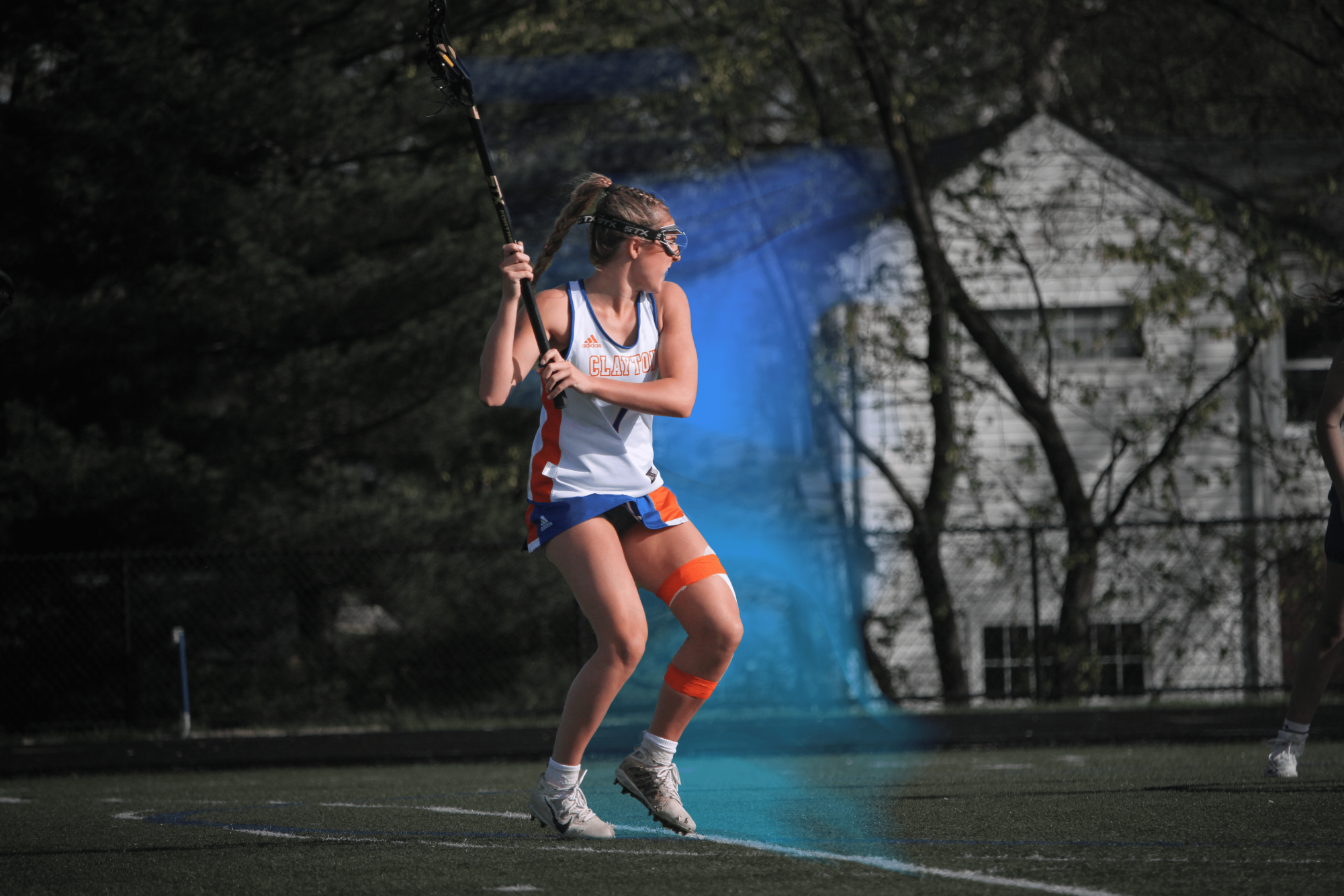
All club athletes at some point in their career, must face the question of whether or not their sport is something they want to pursue on the collegiate level. Yet, with the rise of competitive and dedicated young club athletes, the college pool for any division is becoming more and more competitive. McAndrew described the college process to be like a bloodbath.”
Next College Student Athlete, or NCSA, in 2024, noted the stark numbers of college athletes who played their club sport in high school and their success in college sports. Based on an NCAA study of college sports, 88% of women and 77% of men playing college soccer had previously played club sports. Similarly, in club sports participation, 94% of women in softball, 85% of men in baseball and 79% of field hockey players who are playing their sport in college played club in high school. Additionally, 92% of women committed to college basketball had played on a competitive club team in their high school career.
The numbers show success, but many athletes who go through club sports and do not find success ask themselves what the cost was of going through the intensity of club and risking their mental health for the opportunity for a good chance at getting into a certain college.
Although Vetter and Leonard are committed or planning on committing to soccer at the D1 college level, despite her passion and loyalty, McAndrew has decided not to pursue the sport in college.
Because of this, McAndrew has consciously decided to play the third-string team in her league, meaning she could be on her league’s top team, but she chooses to stay at a lower level.
“I think as you move up the ladder, and get to more competitive teams, these coaches are like, ‘If you want to go to college, this is the team you want to be on, and that has to be your only goal. It doesn’t matter what you’re doing in school because we are going to get to the point where you can go to school for this.’ But if you’re not good enough or decide you don’t want to go to school for soccer, what happens when you’re failing in school and you can’t get into the school you want?” McAndrews said.
The process for Vetter got more difficult after she committed. On Lou Fusz, Vetter and her teammates learned a lesson from those the year above them. Last year, she recounted how once athletes committed, it was common for them to stop trying, having grades and practice attendance slip. So Vetter stayed to a strict training schedule and maintained consistently to stay motivated after she committed.
“I knew that it was only gonna get harder from there,” she said. “When you get to college, you have to be sharp and ready because preseason starts July 21. So, going into that environment with all these players who have been playing college pushes me to want to be better.”
The shift from not just one club to another club can be difficult and trying, but also the change from competitive club in high school to professional college sports.
“When you’re on your club team, you’re usually one of the best, but you’re gonna be just like everyone else once you get to college. It’s a change. Honestly, it’s affected my mental health a little bit just because I think I’m bad, and I have to overcome that. I mean, after I got recruited, I could have just stopped going to practice, but I knew I couldn’t do that,” Vetter said.
Vetter had scouts following her progress since her sophomore year, but the process of actually committing to a college can be brutal. However, many athletes and coaches describe the college commitment process as demanding and rigorous, especially in highly competitive sports like soccer at the D1 through D3 levels.
“If you can’t get the scholarship or the coach’s approval on a school that you’ve been working hard to get into through soccer, then you’re kind of screwed,” McAndrew said. “You could have a personal relationship with a college coach, and then some random kid comes along who is better than you, and the coach will drop you completely and go straight to this recruit.”
For Leonard, college soccer has been a goal for a long time. Unfortunately, Leonard tore his meniscus in a practice in November, and has been out of play for four months. His injury has kept him out of games for a while, but he still manages to make it to every practice, game and tournament he can.
After multiple weekends of college visits and outreaches from colleges, recruiting season has been busy for him. In June last summer, the University of Pennsylvania, the University of Southern Florida and Kansas State had all reached out to him with offers.
“I’m leaning towards USF. I went on an official visit with them for three days, and I worked with the players, and at one of their games, I was out on the bench. Then, at the very end of it, they said that they’d give me an offer soon, and this is back in November,” Leonard said. “But the day after I got back, I ended up hurting myself. So, that kind of slowed down the process again, but I’m trying to get back into it now.”
While this setback may have lengthened the college recruitment process, Leonard recognizes that STL City soccer has done a lot to help him get into college.
Although these club teams are the stepping stones that are trying to make the college process easier, they can also make it more mentally challenging, placing pressure on teenagers who want to go to school for their sport. According to the Psychiatric Times in a study conducted in 2022, 68% of the surveyed athletes met criteria for a major depressive episode, with 34% meeting diagnostic criteria and 26% self-reporting mild to moderate symptoms of depression post competition. The depression prevalence doubled among the top 25% of athletes.
Vetter chose to forgo her season with the high school girls’ soccer team, where she had strong friendships and held leadership roles. In line with the guidelines set by the MSHSAA, public schools strictly enforce rules that prevent athletes from playing for club and school teams during the same season to ensure fair play and avoid conflicts of interest.
Due to these rules, Vetter opted to play lacrosse instead. Despite her experience with playing club lacrosse since fifth grade, soccer was where her passion was.
She recounted a moment at the girl’s soccer senior night in 2023, in which the roaring crowd was lively and excited, as it had been such a close game. The boy’s baseball team had come out after a game to watch, and Vetter was taking stats. The game went into overtime.
“I wanted to be on that field. It hurt,’ Vetter said. ”You have to make sacrifices, knowing what’s best for you. I knew club was what was gonna be best for me, but on that night, I told myself, nope, I’m playing high school next year, and considered it, but I wasn’t looking far enough into my future, which forced me to mature a lot.”
Leonard faced the same concerns and disappointments, noting how it could harm his perception of a normal, fun high school experience.
“I wish I could [play on the Clayton team], because pretty much all my friends are there on the team, and they have team bondings and stuff,” he said. “It takes away from [my high school experience], because I can’t play high school sports, and It’s a trade-off and a sacrifice.”
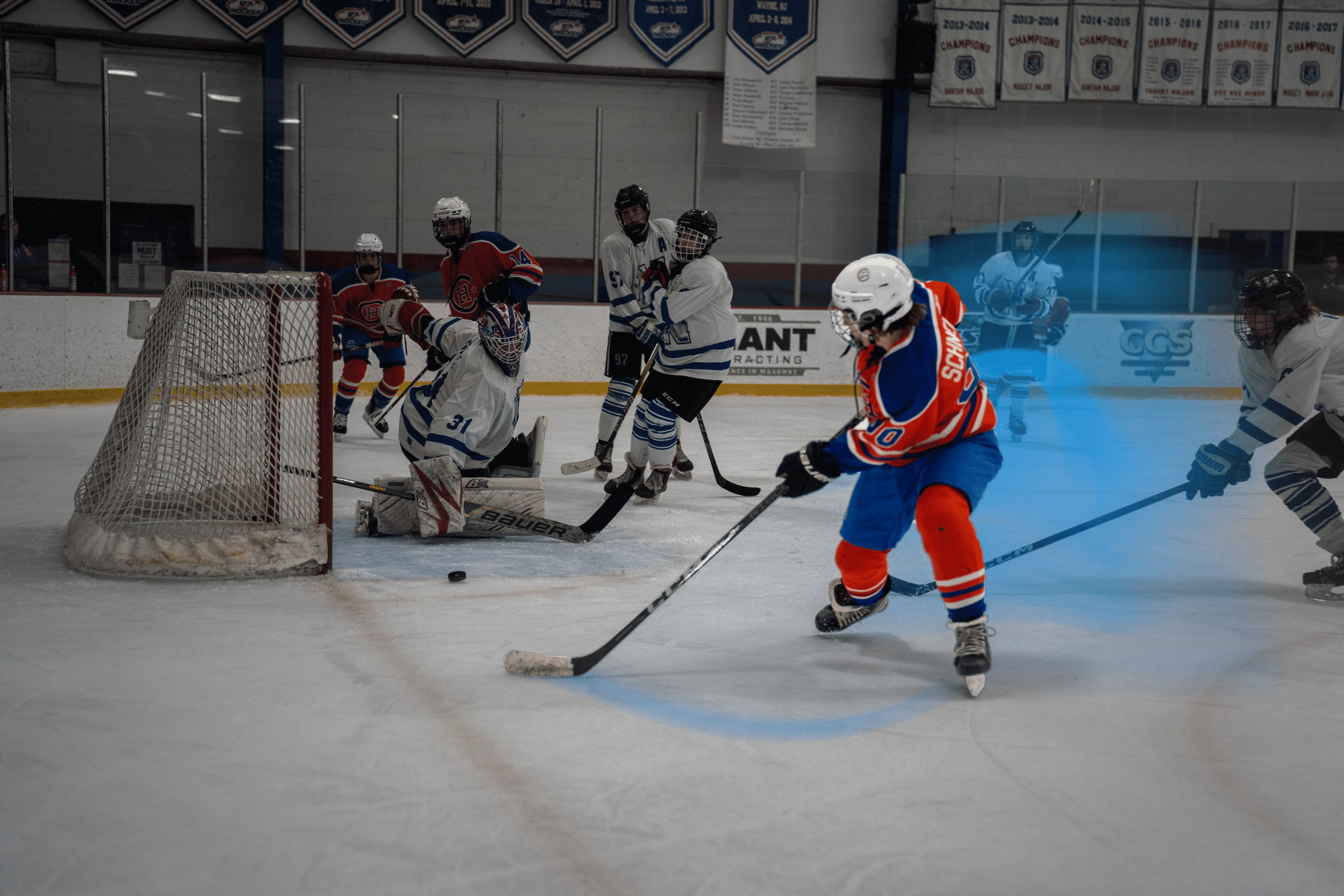
Pain and injuries are a price some have to pay if they want to continue playing the sports they love. However, it is not uncommon for an injury to occur due to a sheer lack of enthusiasm for the sport. According to the Journal of Athletic Training, Sports burnout has a twofold increase in injury risk among adolescent athletes.
Senior Stella Whitney has competed in soccer, basketball and golf for three years. She began playing soccer competitively in club leagues in the sixth grade and has continued since then.
One fall afternoon, on Oct. 24th, while Whitney was at club soccer practice, she went to change directions during a skill.
“My knee just completely buckled, I heard lots of pops and then my leg locked up, and I couldn’t put any weight on it without being in severe pain,” Whitney said.
She tore her ACL and lateral meniscus twice, one completely and the other partially. This occurred one week away from basketball season and seven months out from the soccer season. “At first, I always asked myself questions like, ‘What if I just didn’t go to practice? What if I had just not pressed the ball that one time?’” she said. “There were days when I questioned if I even wanted to be alive if I couldn’t play soccer.” Her injury not only took a toll on her social life but also on her school life. As her mental health declined, so did her grades.
“I couldn’t focus in school, and for about a month after my injury, I was in a really bad mental space,” Whitney said.
A torn ACL turned into more as Whitney was unable to focus on her school work, causing her to miss her sports and also her classes. Mental health is a huge problem when it comes to injuries in sports, according to the NCAA, the psychological response to injury can trigger or unmask serious mental health issues such as depression, anxiety, disordered eating, and substance use or abuse.
“My mental health due to my injury is pretty shakey, some days I’m good and then some days I just lose it,” Whitney said.
Pressures to return to her sport started to build, however, it wasn’t from her coach, but from herself. “I felt pressure to play for my teammates even if it meant risking making an injury worse,” Whitney said.
Whitney is not alone in her journey with serious injury recovery; Beacan Mottl, a senior, plays soccer, and basketball and participated in track for two years.
Mottl suffered from two significant injuries during high school sports. The first was sophomore year during a basketball game against Kirkwood High School. An opponent from the other team dove into Mottl’s leg in an illegal tackle, which then twisted and tore his hamstring. His recovery took around four months before he could play again.
Less than a year later, during the first round of districts for soccer his junior year, Mottl was running against his opponent and, in a collision, misplaced his foot in an attempt to keep up and immediately tore his ACL. Five and a half months after surgery, his doctor cleared him to return to his sports.
Just like Whitney, Mottl’s pressure to return didn’t come from his coaches. “The biggest pressure was what I put on myself because I told myself to make it the fastest recovery possible and the injuries only made me want to play more,” Mottl said.
“It was very hard because playing sports is part of a lot of athletes’ identities and allows them to do what they love, but when you can’t move, it gets mentally tough,” Mottl said. “Then after surgery, it gets pretty hard because you can’t even walk normally and seem so far away from getting back”.
Once Mottl returned to sports, he had an underlying fear when playing any of his sports.
“You recover, obviously, but notice differences in your game,” he said. “The things that affect me are I’m still not willing to jump or land on my left leg. I always use two legs or just my right because I know I can, but subconsciously, I am scared to risk it.”
Outside of lower-body injuries during his athletic career, Mottl suffered from two broken hands in his sophomore and senior years of basketball. This forced him to leave the role he specialized in, offense, and pick up defensive strategies instead.
“It affected my outlook [on basketball] because I knew I wasn’t the best shooter or offensive player, so I had to adjust to my role,” Mottl said.
Despite facing significant mental challenges during their injury recoveries, Whitney and Mottl remained committed to their sports. They expressed a willingness to endure the pain and the recovery process again because they felt a sense of responsibility toward their club and high school teams and did not want to face the social and emotional repercussions from their peers after quitting.
“I only have a set amount of time to play the sports I love and hate to miss out on any time,” Mottl said.
Sports injuries can pause, deter or end a high school athlete’s career. With the standards that club sports place on high schoolers, the pressure to return to sports post-injury can be overwhelming and unprecedented. According to The Spartan Shield, about 90% of athletes have experienced an injury at some point in their athletic careers. Of those, around 56% still played through the injury.
While the sheer pressure of club athletics impacts student athletes’ mental health, student testimonials pointed out the benefits that come from the pressure, such as discipline and the formation of friendships.
“Some of my best friends are the people who play club,” McAndrew said.
While McAndrew noted her commitment to club soccer strains her school friendships, she recognizes that her life would be completely different without soccer.
“I would not be the person I am today without the high school and club sports I participated in. They shaped me and forced me to mature,” she said. “I talk a lot about how overwhelmed I am, but really, it’s just showing me that I can handle the amount of stress, and it’s made me more confident in my abilities to take on hard tasks that are really time-consuming. After going through super busy days and schedules, I know I can handle it.”
These benefits are mirrored in Vetter’s everyday life. For her, sports are an escape from school and stressors in her life. Through club, she has recognized that her love of athletics comes from her, not an outside pressure, which is often the case in teen sports.
“I’ve had great club coaches, and I’m lucky to have a great support system. My mom and my dad are not too hard on me. They’re not like, ‘you have to play the sport.’ I played soccer because I loved soccer,” Vetter said.
While Leonard admits the potential downsides of the time commitment and pressure on teenagers’ mental health, he hypothesizes that the standards club holds athletes to might be necessary.
“The club’s trying to make professional players. I have teammates who have signed professional contracts,” he said. “So they have to have this rigor and the pressure.”
It is clear that the focus and intensity of club sports help to develop a stronger skillset and challenge talented athletes, with the added benefit of being able to showcase skills to college coaches during recruiting season, for those who want to play at the collegiate level, according to Kindbridge Behavioral Health.
High school students make friends and build relationships with trainers and coaches that can last years, even a lifetime, as seen with Vetter and McAndrew.
Though these benefits may seem appealing to those who want to build up their resume for college or become a better athlete faster, the pressures these student-athletes face must be considered.
“Club teams are way more focused on athletics than academics for student-athletes, which is definitely harmful to a lot of students with their academics, and honestly their mental health,” McAndrew said. “I just wish the system was different. We need a change.”
A $50 or more donation includes a subscription to the Clayton High School Globe 2024-2025 print news magazine.
We will mail a copy of our issues to the recipients of your choice.
Your donation helps preserve the tangible experience of print journalism, ensuring that student voices reach our community and that student democracy thrives.


